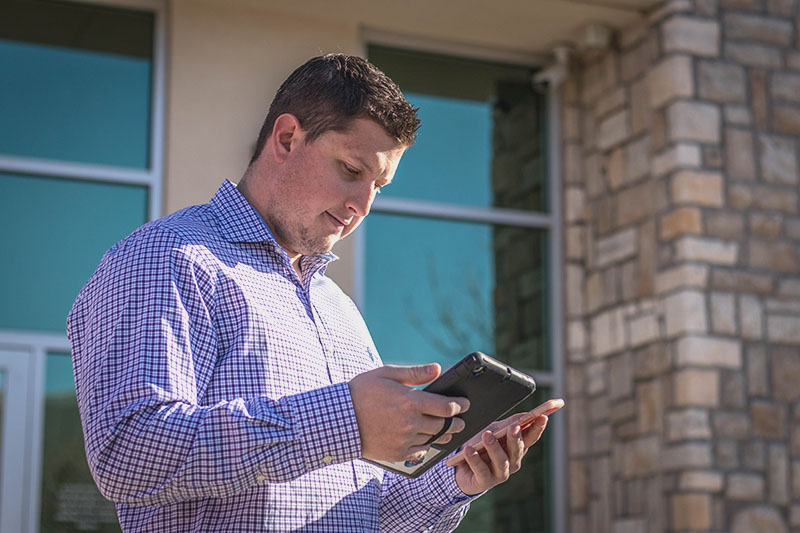By Nate Stein, AccuLynx.
The roofing industry is changing right before our eyes; advancements in new technologies, building trends towards sustainable materials, more safety regulations, and the way we communicate with our leads and customers have all evolved from a simple paper to pencil business model. As these new models continue to invade and improve the roofing and contracting industries, business owners now have a greater stake when it comes early adoption and practical application of new tools and technology as they come on the market.
Using Technology to Help Manage Your Business Workflows
As a roofing business owner, you are constantly tracking new leads through your sales teams on a daily basis, and that volume is directly related to new business you manage every year. While the potential to complete more jobs is exciting, keeping track of all your projects can be a headache – not only for managers, but for office staff as well. Scavenging through your rolodex, cell phone or filing cabinet is a time-wasting activity that doesn’t actively help you be more organized. Investing in business management software specifically built for contractors like a CRM (customer relationship management) or ERP (enterprise resource planning) can streamline your customer acquisition and retainment process, while also allowing you to manage all of your finances and document management for your roofing business.
With a cloud-based data system, you eliminate the possibility of ever losing a customer’s information, while gaining unlimited access to the files and documentation your field staff need on a daily basis. Various departments in your business no longer need to refer to different databases, with out of date or conflicting information. All information is stored in one, centralized location, ensuring everyone has the same, accurate data.
ERPs give you the ability to manage the “business” side to your business, with integrations to procure supplies from your local branches, enter data and manage commissions, supplements and financial tracking with QuickBooks, and create estimates, contracts, and other necessary paperwork for jobs with the click of a button.
Business management has come a long way from Excel and carbon copies – roofers that take advantage of software have seen impressive returns on their ROI.
“It’s valuable to look not only at how quickly the company will gain back the initial investment in terms of cost-savings, but also at the number of man-hours the estimating team will save. When software reduces the number of hours spent estimating a project, it frees up time to bid and win more projects—which can multiply revenue many times over. [source] “
Take Flight with Drones & Aerial Roofing Measurements
Gravity no longer limits your abilities as a roofer. With aerial measurements and drone image capturing, you as a roofer have the option to expand your estimating and ordering capabilities through improvements in the way you approach any roof. Companies such as EagleView and SkyMeasure simplify the measuring of roofs. Instead of having your field staff climb on top of roofs all day and manually measure slopes and areas, you can place an order for an aerial roof measurement, automatically populate estimates and produce more accurate paperwork to homeowners and material suppliers.
Drones are also continuing to alter the roofing landscape. Equipped with 4K cameras, personal and professional roofing drones can fly over homes and capture detailed pictures of problem spots, which your sales team can then show to your leads in order to better visualize and explain issues and communicate with homeowners. Better yet, these drones can also be used to snap pictures of potential hazardous spots on roofs, so your crews can be well informed and prepare before they set a single foot on a roof again.
Direct Connections and Integrations with Material Suppliers
How have you been ordering your shingles, nails, and gutter coil up until now? Well, just like most every other roofer out there, you probably picked up the phone, made a call to the sales rep at your local branch, chatted for a few minutes, and then went on to ordering supplies for your roofing project. The all-too-classic happens, when you ordered black shingles, but you received brown ones, and those 1” nails you ordered ended up arriving as 1 ¼” nails.
While mistakes happen, it is annoying and unnecessary in today’s technologically advanced roofing world. Now, you can place orders with your local vendors online. New software tools allow you to browse different products that your supplier offers with real-time prices. From GAF Timberline Shingles to endless house wraps and sealants, you can order anything you need for all your roofing jobs. Real time pricing ensures you get up to date prices, so you can build accurate estimates. With supplier-direct ordering, you won’t receive those brown shingles and 1 ¼” nails you never ordered, and you can show your prospect an accurate estimate of what the project will cost.
The roofing industry is changing – processes that were once tedious, annoying, and time-consuming have been streamlined and automated by software and technology that help your business operate more efficiently across all of your teams. Embracing the dynamic changes happening today may seem overwhelming and impossible to keep up but provide limitless potential as you continue to scale and grow your business.
Note: This article first appeared on the AccuLynx blog and can be viewed here.

